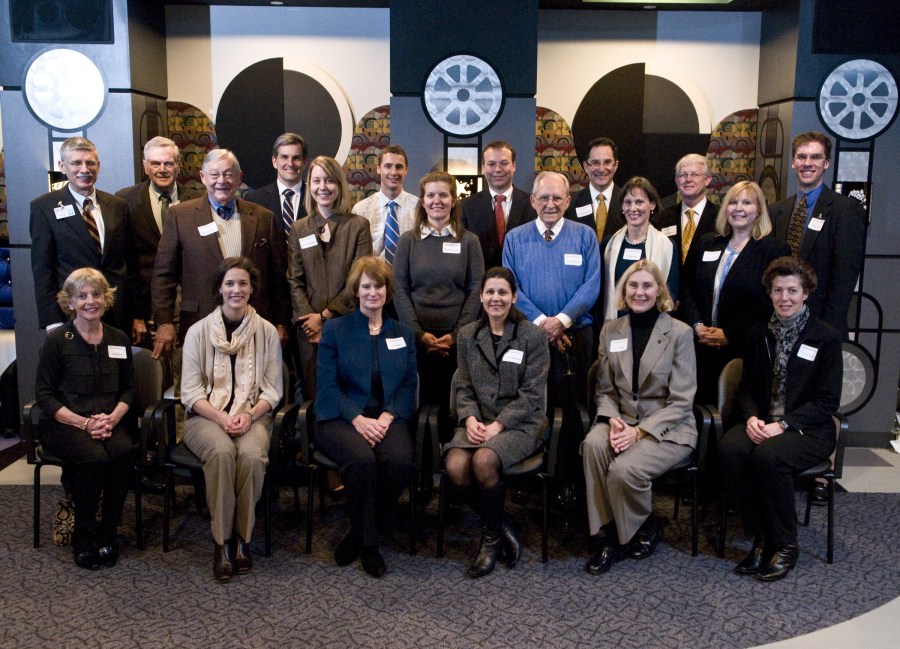
Members of the Coalition for the Canby Robinson Society include: (front row, from left) Judy Simmons, Shannon Snyder, M.D., Kitty Murfree, Maria Frexes-Steed, M.D., Ph.D., Ann Price, M.D., Tina Hartert, M.D., (middle row, from left) Doug Twells, Robert McNeilly, Emily Rose Shearon, Mary Beth Thompson, Lonnie Burnett, M.D., Ellen Wright, M.D., Robin Kumar, (back row, from left) Robert Collins, M.D., John Zic, M.D., Oran Aaronson, M.D., Jeff Balser, M.D., Ph.D., Paul Sternberg, M.D., R. Kent Farris, M.D., and Todd Jackson. (photo by Mary Donaldson)
CRS Coalition works to spread the word
A group of “ambassadors” for the Canby Robinson Society is making an impact not just on medical practice at Vanderbilt, but on the future of medicine itself.
The Coalition for the Canby Robinson Society is a group of 30 volunteer members who pledge to spread the word about the great work being done at Vanderbilt University Medical Center.
At the coalition's second annual dinner earlier this month at the Monroe Carell Jr. Children's Hospital at Vanderbilt, Robert McNeilly Jr., coalition co-chair and former CRS president, said the coalition has made great strides since it was formed last year.
For example, in 2009, 339 people in 30 states were asked to support the Medical Center at the $1,000 level.
“Each and every member of this coalition made a call over the last year. They are increasing the national recognition and understanding about Vanderbilt. It is an easy sell when you think about the amazing and transformational things that are happening at the Medical Center,” McNeilly said.
Robert Collins, M.D., professor of Pathology, and Judson Randolph, M.D., co-chair the effort with McNeilly. Collins said the importance of the work of the volunteers in the coalition cannot be understated.
“This institution has been dependant on philanthropy since day one. A medical center like ours is most successful when talented faculty and staff work with volunteers to carry out its mission. Among the volunteers are the generous philanthropists who enable us to do special and unique things in terms of teaching, research and patient care,” said Collins.
CRS President Paul Sternberg, M.D., assistant vice-chancellor for Adult Health Affairs, told the coalition that the society's plan will place an increasing emphasis on support for training the best of the best in medicine, regardless of ability to pay.
“If there is one thing I want to emphasize in my term, it is the funding of medical student scholarships; I want medical education to be a key priority for us,” Sternberg said.
Jeff Balser, M.D., Ph.D., vice chancellor for Health Affairs and dean of Vanderbilt University School of Medicine, also spoke at the dinner.
He shared news about everything from the development of transformative bio-informatics programs to the launch of BioVU, Vanderbilt's cutting-edge DNA databank.
Balser also encouraged coalition members to think about scholarship support.
“It's very personal,” said Balser, who attended Vanderbilt thanks to scholarship support.
“We need to keep in mind that one cannot always predict the impact of a scholarship on the life of a student, and some will explore possible career opportunities only because scholarship support limits their debt load. We are now competing head to head with the greatest institutions in the country for the very best students.
“We need to continue to expand our scholarship resources, as there is no doubt there are many future leaders in science and medicine who will not be able to come to Vanderbilt without significant financial aid,” Balser said.
The CRS has for 30 years encouraged and honored those who give financial support to the education, research and patient care programs of the Medical Center. Over this time, CRS has provided 65 full scholarships, while also becoming the umbrella organization through which a host of clinical and research programs are sustained.
George Canby Robinson was dean of VUSM from 1920-1928. He helped usher Vanderbilt's medical training program into the modern era by constructing the Medical Center building on 21st Avenue that put teaching, patient care and research capabilities under one roof.













